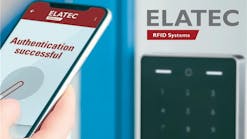The smart home movement continues to drive increased interest and demand for more electronic access control locks and “smart” devices that work in tandem with a home’s overall security system. Add to that the proliferation of the smartphone as the main source to control all these systems and devices, and we are now seeing how residential security is evolving and influencing even the way people look at security and access control in multi-family and small- to medium-sized businesses. While the final piece to the smart home puzzle – interoperability – is still a work in progress, unifying standards such as Matter are helping in the quest to make all these devices work seamlessly together.
Parks Associates reports that 43% of U.S. Internet households have a security solution – either a system or a device – and 32% subscribe to a security service. Since July 2022, there has been a 5% increase in adoption of either a video doorbell or a camera without a system, which represents approximately six million homes that have added this type of solution in the past 18 months.
Parks Associates President & CEO Elizabeth Parks says security devices are driving the market forward now.
“Choice for consumers is huge, as they continue to have lots of choice for security solutions systems and devices that have pro and self-monitoring options,” she points out. “There is a move to the early majority market and an expansion in smart home device solutions across households. Now 45% of households have at least one smart home device and more and more buyers are buying these products for the first time. The average household has 17 connected devices.”
Security Driving Interaction
Parks Associates’ research reveals 40% of households with connected home devices have at least one multidevice integration or routine established today.
“Those owning security systems, or an access control device (a smart lock or smart garage door opener) are particularly likely to coordinate smart actions,” explains Jason Paris, VP, business development, Parks Associates. “Smart access routines also rank among the most appealing, involving integrations of locks, cameras/doorbells, lights, thermostats, and security systems. These routines are designed to enhance household convenience, security, and energy efficiency.”
While 40 percent are already doing integrations, that still leaves “60% of households with smart devices [that] are using them as point solutions, leaving a large portion of their value unrealized,” notes Parks.
As part of the research noted above, the firm tested and quantified the appeal of nearly 100 unique routines among all Internet households. And as Parks points out, smart home device owners are largely underutilizing their products with 60% reporting having no coordination between devices.
“Much of the value — and vision — of a helpful, intuitive, personal smart home requires coordination among devices, and the dominant method of buying point solutions to solve specific needs isn’t achieving that whole-home promise,” she explains. “Security providers are trusted by consumers, especially with the data, and consumers go to their system app to control other devices in the home.”
The research notes that word-of-mouth and personal recommendations are crucial drivers for smart home sales, so it is imperative users see the full value of their products so that they can then be product promoters.
The Heart of the Matter
As noted earlier, the realization of full interoperability may be the final piece that drives even more widespread adoption of security systems and products within the home. Managing the infrastructure in the home (routers, Wi-Fi networks, etc.) is part of the focus – ensuring reliability of connected devices working together seamlessly in the home, notes Parks.
In addition, creating a universal communication standard so devices can work seamlessly together is another big area of focus, which has led to the introduction of Matter by the Connectivity Standards Alliance (CSA), an industry–unifying standard for secure and reliable connectivity. Matter, which has the backing of behemoths including Apple, Google, and Amazon, as well as a long list of well-known lock manufacturers, is pushing to create more connections between more devices, as well as to simplify development for manufacturers, and increase compatibility for consumers.
“Matter is making slow progress like any other standard does – much slower than they told the industry it would go – so naturally people are weary,” says Parks. “Expectations weren’t set right and therefore just haven’t been met. At the same time, progress is being made! Companies will scrutinize this expense as well in the second half of 2024 and into 2025, especially as the standard works to bring on more devices.”
She continues, “Interoperability is an age-old problem the industry will continue to try to resolve to help move the smart home closer to mass market.”
As the residential market moves closer to solving this dilemma, Paris adds, “There is clear consumer demand for integrated and customizable smart home experiences, with a significant emphasis on security, access control, and energy management. Smart home providers need to balance between offering advanced automation and respecting user preferences for control.”
The Role of DIY
The past five years have included a realignment of the residential security market with consumers shifting their buying, installation, and monitoring choices. As new households and competitors have entered the market, security providers are adapting to the pressures of a changing customer base, increased competition, and a challenging economic environment.
For example, Parks Associates research shows that 8 million Internet households have had subscriptions to a professional monitoring service for more than 5 years straight.
“In the security monitoring industry, reducing attrition hinges on creating 'sticky' customers through offering superior customer service, innovative and customizable security solutions, and value-added features that integrate seamlessly with customers' lifestyles,” notes Parks. “As more providers add no-contract monitoring services attached to self-installed systems, providers must consistently promote and integrate additional devices and services into their offerings.”
Regular usage of a product or service tends to enhance the perception of its value, as frequent engagement and familiarity often lead to increased reliance and appreciation.
As Parks points out, security providers are continuously looking to find ways to engage customers but not bother them.
“Understanding the switching behaviors of security providers is important for today’s traditional and incoming industry players,” she explains. “Intentions to subscribe to professional monitoring have increased dramatically among security households with no professional monitoring. DIY systems have proliferated. Some DIY security households find their self-monitoring status unsatisfactory. This is the step up that DIY security providers hope for. The anticipated transition from do-it-yourself (DIY) to professional services in certain aspects is expected to occur, reflecting a shift in customer preferences and industry practices.”
Challenges Ahead
One continuing challenge for local security companies is competing in a market increasingly dominated by national chains and tech giants. Parks Associates reported at ISC West in April that only 7% of U.S. Internet households that bought a security system in the past 12 months purchased through a local home security company, a significant drop from 22% in Q4 2021.
Parks says this is caused by many factors, including a rise of the national players, the consumer going online to make purchases, and more competition from security devices driving consumers to reconsider the system purchase.
“Consumers are buying more from national providers and significantly less from the local dealers,” she says. “The hardware companies need to better support the local dealer market. For small, local companies, competing in a market increasingly dominated by national chains and tech giants presents significant challenges.”
The research firm’s recent study, Residential Security Dashboard, highlights adoption of security systems and the challenges facing small, local security businesses, including limited marketing budgets, lesser brand recognition, and the complexities of offering cutting-edge technology at competitive prices.
With research showing more and more households are buying from national security providers and big-box retailers since 202, what does this mean for local home security dealers and locksmiths?
“It’s not doom and gloom, but the market is hard,” Parks emphasizes. “Consumers are scrutinizing their expenses and so will switch to save money or might consider upgrading to more robust services. Security companies need to add value to the service, create more stickiness, and lean into what consumers want – a lot of that right now is around video solutions and providing more context.”
She adds that manufacturers also need to help the local dealers and businesses. “This is a critical channel that needs to be propped up. Small businesses are at risk and this puts the large business at risk. Providing the necessary support, education, and tools to dealers is of critical importance for the second half of the year, especially as inflation continues, labor is hard to find and expensive, and consumers have more choice than ever in their security solutions “
The research firm emphasizes that hardware manufacturers can empower local security companies by providing access to the latest security technologies, training for installation and maintenance, and partnership opportunities for co-branded marketing initiatives. They can also help support the smaller players by offering scalable solutions, preferential pricing strategies, and technical support that can help level the playing field. These efforts would allow smaller companies to differentiate themselves through personalized service and local expertise.
“This support not only aids in the survival of small businesses in the face of industry consolidation, but also ensures that customers continue to have access to diverse security solutions tailored to their specific needs,” says Parks.
Paul Ragusa | Senior Editor
Paul Ragusa is senior editor for Locksmith Ledger. He has worked as an editor in the security industry for nearly 10 years. He can be reached at [email protected].









